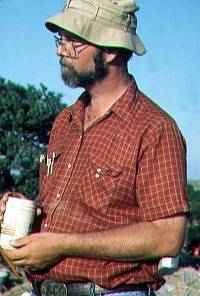Credits & Sources
|
The Buried City exhibit was written by Dr. David T. Hughes, associate professor of anthropology at Wichita State University, where he has taught since 1988. Hughes has been directing field investigations and subsequent analysis of Buried City since 1985. Son of Jack T. Hughes, David has been involved in archeology since early childhood. He holds a Ph.D. from the University of Oklahoma. He makes his home in Newton, Kansas where he lives with wife Dr. Alicia Hughes-Jones, a fellow archeologist who has served as David's confidant, editor, goad, colleague, office manager, lab manager, co-project director, and sounding board. As he puts it, "Whatever I may have accomplished is at least as much the result of her efforts as of my own." David got his first field experience excavating bison kill sites under Billy Harrison in 1968, had his first technical report published in 1974, and has been actively doing archeological research for over 35 years. Hughes has published dozens of technical reports and scholarly articles. He has worked with Earl Greene at Ft. McKavett, Frank Weir for the Texas Department of Highways and Transportation, Vance Haynes at the Lehner and Murray Springs sites, Don Wyckoff at the Oklahoma Archaeological Survey, and scores of people on contracts and summer employment in Alaska, North Dakota, Nebraska, Colorado, New Mexico, Nebraska, Kansas, Louisiana, and beyond. In recent years his interests have broadened to include ethnohistory and ethnography. He has directed ethnographic studies in St. Louis and Pipestone, Minnesota as well as extensive ethnohistoric studies for Pipestone National Monument and for the Scotts Bluff and Agate Fossil Quarries National Monuments in Nebraska. The investigations at the Buried City since 1985 were funded largely by the Harold Courson family with additional support from the field schools of the Texas Archeological Society and Wichita State University, as well as small private contributions. Institutional support in the form of personnel and facilities was provided by the Panhandle-Plains Historical Museum, the Texas Historical Commission Office of the State Archeologist, the University of Oklahoma, and Wichita State University, among others. The photographs used here were taken by David T. Hughes, Madeline Jeffress, Steve Black, and Wallace Williams. Many photographs were drawn from the Courson Archeological collection currently housed at Wichita State University. Graphics and maps were prepared by Hughes as part of past or planned publications on the Buried City. The ideas and concepts presented here resulted from observations made during the investigations and were refined, expanded or, in some cases altered, as the result of conversations with other archeologists such as Don Blakeslee, Todd Bevitt, Scott Brosowske, Doug Boyd, Joan Few, Mott Davis, Tom Ellzey, Billy and Donna Harrison, Jack Hughes, Ron Ralph, Harry Shafer, Susan Vehik, and Doug Wilkens, and many others. The list of crew members involved in the Buried City research would fill several pages. We began with a crew of five in 1985, expanded to about 15 in 1986, had 300 TAS members in 1987, and by some reports, 400 in 1988. In 1990 WSU students involved in the Temple excavation numbered about 40 all told. Alicia Hughes-Jones was the lab and office manager, records concordance supervisor, and co-director throughout. Danny Witt was a key local informant and expediter as well as willing and informed worker in all phases of the work. The Courson family has volunteered their time, talent, and perspiration as well as fiscal support, ever willing to offer advice, suggestions, and labor when needed. The efforts of all who have helped on Buried City are greatly appreciated. Steve Black edited this exhibit and put it together with the help of webmaster Meg Kemp. Print SourcesEyerly, T. L. 1908 Buried City of the Panhandle. Transactions of the Kansas Academy of Science, Vol 21(1):219-228, December, 1907. Download PDF file. 1912 The Buried City of the Panhandle. The Archaeological Bulletin 3(1):1-5. Download PDF file. [Eyerly's reports all have substantially the same content.] Franklin, C. B. Krieger, Alex D. Moorehead, Warren King 1931 Archaeology of the Arkansas River Valley.
Published for the Department of Archaeology, Phillips Academy, Andover,
Mass., by the Yale University Press. Suhm, Dee Ann, Alex D. Krieger and Edward B. Jelks
1991 Investigations of the Buried City, Ochiltree
County, Texas. Bulletin of the Texas Archeological Society
60:107-148. 2002 Buried City Ceramics, Ochiltree County, Texas.
A paper presented at the Plains Anthropological Conference, Oklahoma
City, October 2002. Hughes, David and Alicia Hughes-Jones |
|
